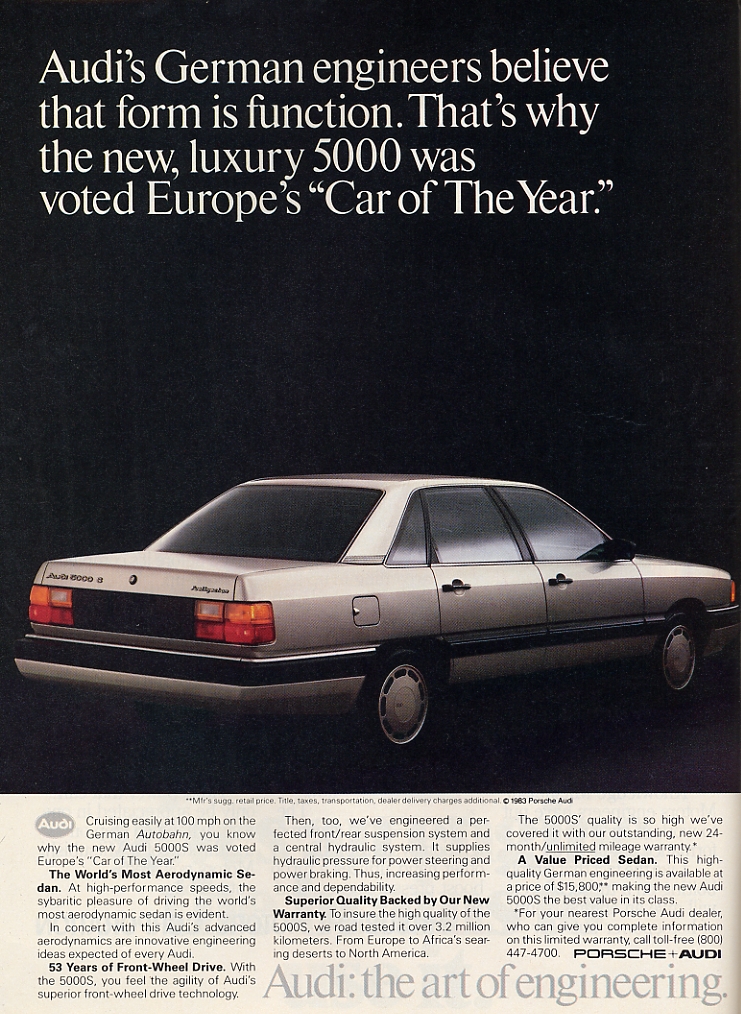1984 was the first year for Audi’s new aerodynamic design for their biggest sedan. At the time, the exterior design was differentiating—though many would follow, Audi’s was first. Despite being the top-of-the-line, the 5000S was not a large car by modern standards—every dimension was smaller than Audi’s current A6 sedan.
The standard powertrain on Audi’s new sedan was Volkswagon’s corporate 100 bhp 2.1 liter/123 ci inline five with Bosch K-Jetronic fuel injection mated with a five-speed manual transmission. An automatic was available with the standard engine. The automatic was the only transmission available with the upmarket Turbo option—the same engine with a KKK turbocharger that made 140 bhp.
Period road tests showed 0-60 times of 10.6 seconds for the Turbo, making it not much quicker than the base 5000S but almost 20 mph faster. Fuel economy ratings for the Turbo were 19 city/28 highway by the standards of the day (15/20 by today’s standards). With a 21.2-gallon gas tank, the driver of a new Turbo could expect a 335 to 445 mile range with a 10% fuel reserve.
Standard exterior and mechanical equipment on the $16,840 5000S (about $42,800 in today’s dollars—approximately what a 2019 A5 costs) included halogen headlamps, flush-mounted window glass, power rack-and-pinion steering, power front disc/rear drum brakes, and 185/70SR14 tires (a size still readily available) on 14 x 6 inch aerodynamically styled lightweight aluminum wheels.
Inside, standard features included Electronic Climate Control, cloth bucket seats, a center console, and power windows. Features that look strange to our modern eyes included an illuminated ash tray and a “radio prep kit with power antenna” and four “high-quality” speakers.
Exterior options for the 5000S included an electric two-way tilting/sliding sunroof, power heated mirrors, and metallic paint. Inside, leather seats, heated seats, and a trip computer were all available.
In addition to more power, the Turbo package included an electric two-way tilting/sliding sunroof, a slightly tighter suspension, four-wheel disc brakes, and 205/60HR15 tires (also still readily available) on 15 x 6 inch aluminum wheels. Inside, power seats, power door locks, a trip computer, and a “fine-sounding” Audi Design/Blaupunkt AM/FM stereo radio with a cassette player and four speakers were included. The Turbo‘s $5,570 additional cost brought it up to about $56,900 in 2019 dollars—more like today’s A6 pricing.

Reviews of the new design were quite good, and sales reflected that. Then, of course, things all went horribly south with the unintended acceleration controversy. Sales would crater, and it would take Audi many years to recover.
5000S’s sometimes show up in the Hemming’s Motor News classifieds and eBay Motors, but there’s not a lot of activity. As I write this in September 2019, there’s a Nautical Blue Metallic 1987 5000S with gray velour bucket seats, a five-speed manual, and 59,000 miles being advertised on Hemmings and asking $7,000.
Make mine Sapphire Metallic, please.
